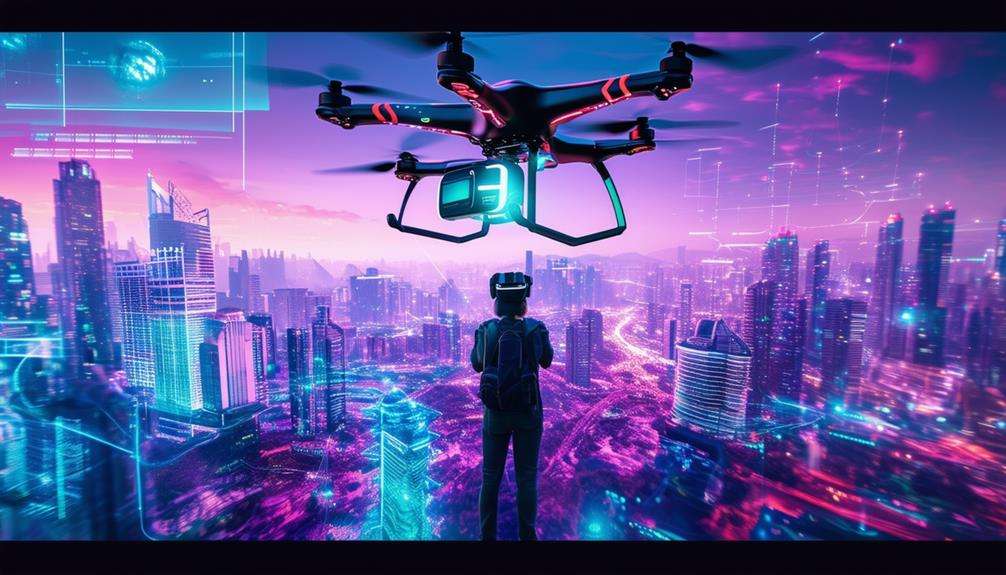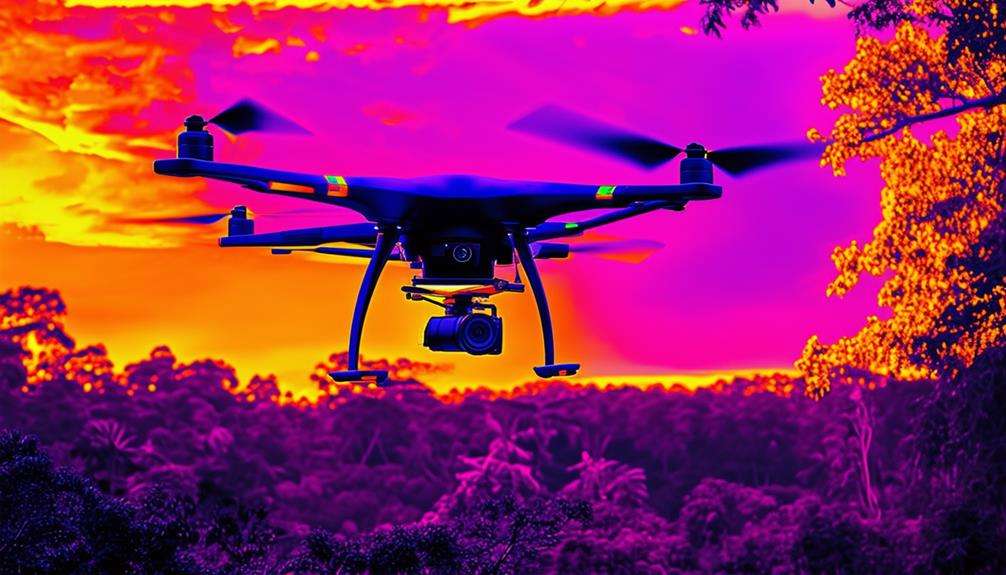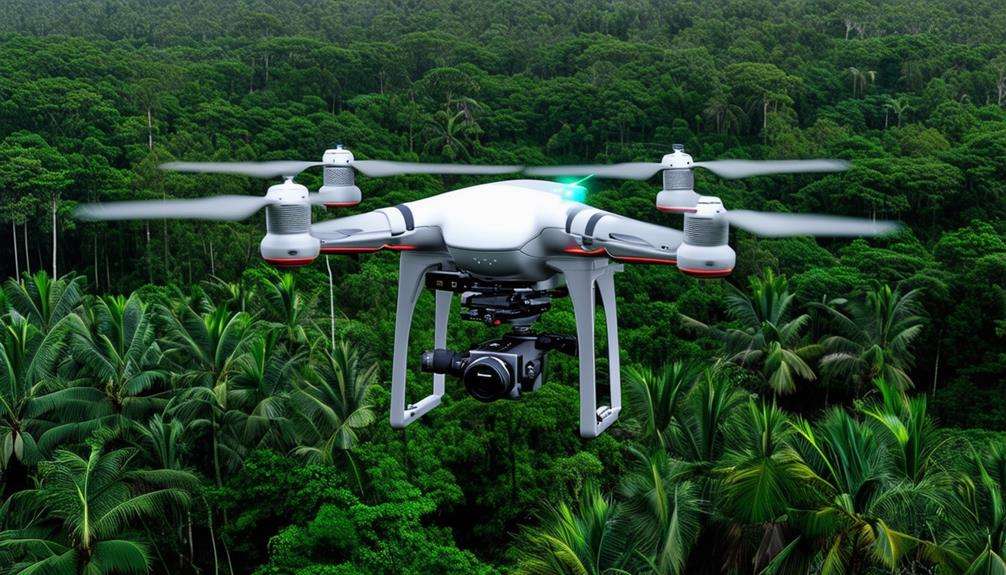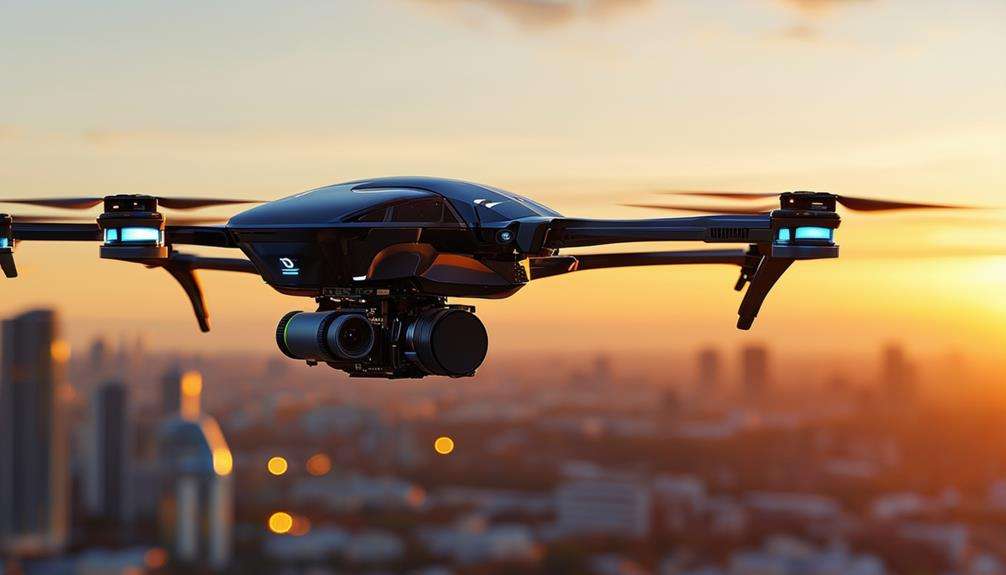UAV Innovations: Cutting-Edge Drone Technologies and Their Uses
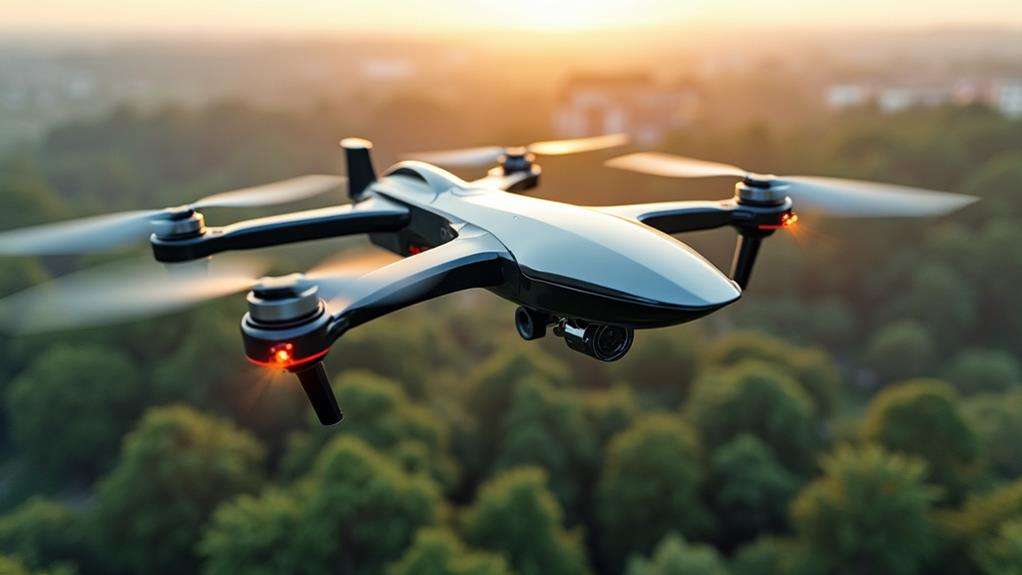
Imagine harnessing UAV innovations to transform industries like agriculture, infrastructure, and emergency response. With cutting-edge technologies such as AI-driven decision-making, Beyond Visual Line of Sight (BVLOS) operations, and Vertical Takeoff and Landing (VTOL), drones are setting new standards for efficiency and adaptability. These advancements not only enhance safety and sustainability but also introduce unprecedented operational flexibility. The question now is: how do these sophisticated features translate into real-world applications, and what future developments can we anticipate in this rapidly evolving field?
Beyond Line of Sight Operations
Beyond Line of Sight (BLOS) operations for UAVs are redefining the possibilities of unmanned aerial missions. These advanced capabilities allow UAVs to conduct tasks over extended ranges, making them invaluable for first responders and other critical applications. For instance, in a search and rescue mission where direct visual contact is impossible, BLOS enables UAVs to perform long-range surveillance, covering vast areas quickly and efficiently.
The success of BLOS operations hinges on cutting-edge communication and navigation systems. These technologies ensure UAVs can operate effectively even when they're out of the operator's sight, enabling real-time data transmission over long distances. This enhances both operational efficiency and mission effectiveness.
For first responders, BLOS operations have revolutionized emergency response. UAVs can now deliver medical supplies to remote locations much faster than traditional methods. This capability is transformative not only for emergency scenarios but also for industries that rely on real-time data collection and rapid decision-making.
With BLOS technology, UAVs are not just advanced flying devices; they are essential tools that can save lives and improve operational outcomes across various sectors.
AI and Machine Learning in UAVs
Integrating AI and machine learning into UAVs transforms their capability to make autonomous decisions and analyze data in real-time. Drones can adapt to dynamic environments, improving mission efficiency and safety. These technologies allow UAVs to enhance performance by learning from previous missions and forecasting environmental conditions.
Autonomous Decision-Making Systems
Artificial intelligence (AI) and machine learning are revolutionizing unmanned aerial vehicles (UAVs) by enabling autonomous decision-making systems. These technologies empower UAVs to intelligently respond to real-time data and adapt to changing environmental conditions during missions. For instance, imagine a drone swarm navigating complex terrain; AI allows these UAVs to collaborate seamlessly, enhancing operational efficiency and mission effectiveness.
Machine learning algorithms enable drones to autonomously navigate intricate scenarios. They can analyze factors like slope steepness to optimize flight paths, resulting in more successful missions. Over time, continuous learning capabilities allow these drones to refine their performance, improving resource management and reliability, particularly in high-risk situations.
The integration of AI doesn't end there. Future advancements could see UAVs achieving even greater autonomy, taking on roles in independent monitoring and control across various sectors. This level of autonomy could transform drone utilization in areas ranging from emergency response to agricultural monitoring. The fusion of AI and machine learning unlocks the full potential of UAVs, making them smarter, more efficient, and highly adaptable to any challenge they might encounter.
Real-Time Data Analysis
Leveraging advancements in autonomous decision-making systems, real-time data analysis powered by AI and machine learning is significantly enhancing UAV capabilities. By integrating AI, UAVs can adaptively respond to dynamic environments during missions, making them more versatile and effective. Machine learning enables drones to continuously learn from operational data, optimizing their performance and decision-making abilities over time.
AI integration in UAVs facilitates autonomous navigation through complex scenarios, significantly reducing the need for human intervention. This autonomy not only boosts mission efficiency but also enhances the drone's ability to quickly assess and react to changing conditions, such as weather variations or unexpected obstacles. For instance, real-time data processing allows drones to estimate environmental factors like slope steepness, ensuring effective operation across diverse terrains.
Here's a quick comparison of traditional UAVs versus AI-integrated UAVs:
| Feature | Traditional UAVs | AI-Integrated UAVs |
|---|---|---|
| Navigation | Manual or GPS-based | Autonomous |
| Data Processing Speed | Delayed | Real-Time |
| Adaptability | Limited | High |
| Human Intervention | Required | Minimal |
Incorporating AI in UAVs is revolutionizing their operational efficiency, making them indispensable tools in various applications.
Vertical Takeoff and Landing (VTOL)
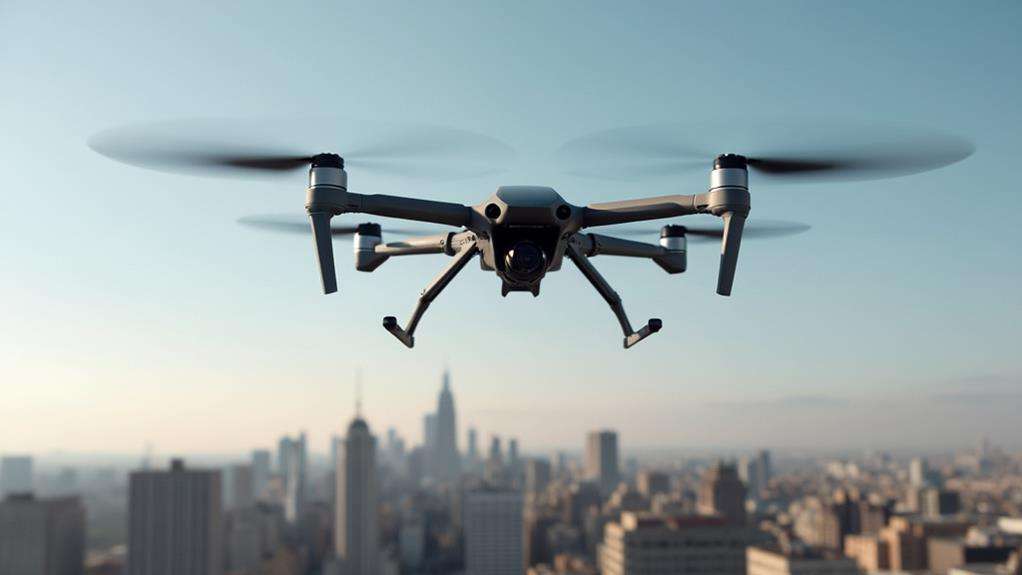
With Vertical Takeoff and Landing (VTOL) capabilities, UAVs can be deployed in urban areas without the need for runways, making them ideal for congested city environments. They also offer significant advantages in precision agriculture, providing access to hard-to-reach fields for crop monitoring and pesticide application. Additionally, VTOL drones excel in infrastructure inspection, enabling the assessment of critical structures like bridges and power lines efficiently.
Enhanced Urban Deployment Flexibility
Vertical Takeoff and Landing (VTOL) capabilities are transforming urban deployment by enabling UAVs to operate without the need for runways, a critical advantage in crowded cityscapes and dense terrains. VTOL technology allows UAVs to take off and land in confined spaces, making them ideal for urban air mobility initiatives and inspecting infrastructure in hard-to-reach locations. Envision a drone that can effortlessly switch from vertical to horizontal flight—this adaptability boosts operational efficiency and reduces mission time, significantly enhancing the value of UAVs in urban environments.
VTOL drones are not only versatile but also robust. Recent advancements have increased their payload capacities and improved their wind resistance, allowing them to carry heavier loads and remain stable even in challenging weather conditions. Whether delivering medical supplies in a bustling city or providing real-time surveillance over dense urban areas, VTOL UAVs offer unmatched flexibility.
Their capability to navigate tight spaces and variable terrains makes them indispensable for numerous sectors. While the next subtopic will explore precision agriculture applications, it's evident that VTOL technology is revolutionizing urban deployment flexibility for UAVs.
Precision Agriculture Applications
Imagine a drone seamlessly taking off from a compact farm plot and spraying pesticides with pinpoint accuracy. Unmanned Aerial Vehicles (UAVs) with vertical takeoff and landing (VTOL) capabilities are revolutionizing precision agriculture. These drones are ideal for diverse environments, from urban fields to dense terrains, as they do not require runways.
The ABZ Innovation L30 UAV exemplifies this innovation. With a 30-liter payload capacity, it can cover up to 21 hectares per hour, optimizing pesticide application and improving operational efficiency. VTOL drones excel in reaching hard-to-access areas, ensuring precise fertilizer and pesticide application. This precision reduces wastage and enhances crop health.
| Benefit | VTOL UAV Feature |
|---|---|
| No need for runways | Vertical takeoff and landing capabilities |
| Efficient pesticide use | Covers up to 21 hectares per hour (ABZ L30) |
| Sustainable farming | Uses up to 50% less chemicals, 90% less water |
| Enhanced productivity | Supports innovative agricultural practices |
Infrastructure Inspection Accessibility
Navigating the complexities of urban infrastructure inspections becomes straightforward with VTOL drone technology. UAVs with Vertical Takeoff and Landing capabilities can operate in confined spaces without the need for runways, making them ideal for dense urban environments and rugged terrains. VTOL drones can easily reach hard-to-access locations like rooftops and bridges, allowing for comprehensive inspections of structures that would otherwise be challenging or dangerous for humans.
The adaptability of VTOL technology makes these drones invaluable across various industries. In construction and energy sectors, they are employed for regular maintenance and safety checks, ensuring that critical infrastructure remains in optimal condition. Equipped with advanced sensors and cameras, VTOL drones can capture high-resolution images and data, enhancing the accuracy and efficiency of infrastructure inspections.
Deploying VTOL drones for these tasks significantly reduces the time needed for assessments. This leads to quicker insights and minimizes potential downtime for essential assets. With these drones, you are investing in a solution that streamlines the entire inspection process, making it safer, faster, and more reliable.
Swarming Technology
Swarming technology leverages the power of collaboration, enabling multiple UAVs to work in unison, thereby enhancing mission efficiency through synchronized actions and optimal resource allocation. A scenario where a single drone might falter is effortlessly managed by a coordinated swarm, thanks to advanced aircraft systems. This collective approach improves operational efficiency and unlocks new potential across various industries.
In agriculture, drone swarms can monitor extensive fields, ensuring comprehensive coverage without missing any areas. Defense operations gain from improved reconnaissance and surveillance capabilities, as multiple UAVs can cover vast regions simultaneously. The collective intelligence of these swarms allows them to undertake complex missions that single drones cannot handle alone. Even in challenging environments where individual UAVs may struggle, swarming capabilities excel.
Key applications of swarming technology include:
- Efficient Crop Monitoring: UAVs scan extensive farmlands, detecting issues early.
- Defense Reconnaissance: Multiple drones swiftly gather crucial intelligence.
- Search and Rescue Missions: Coordinated UAVs locate stranded individuals more rapidly.
- Environmental Monitoring: Swarms track wildlife and pollutants over large areas.
- Disaster Response: Quick and thorough area assessments post-disaster.
As research progresses, the potential applications for swarming technology continue to expand, revolutionizing approaches to complex tasks.
Energy-Efficient Propulsion Systems
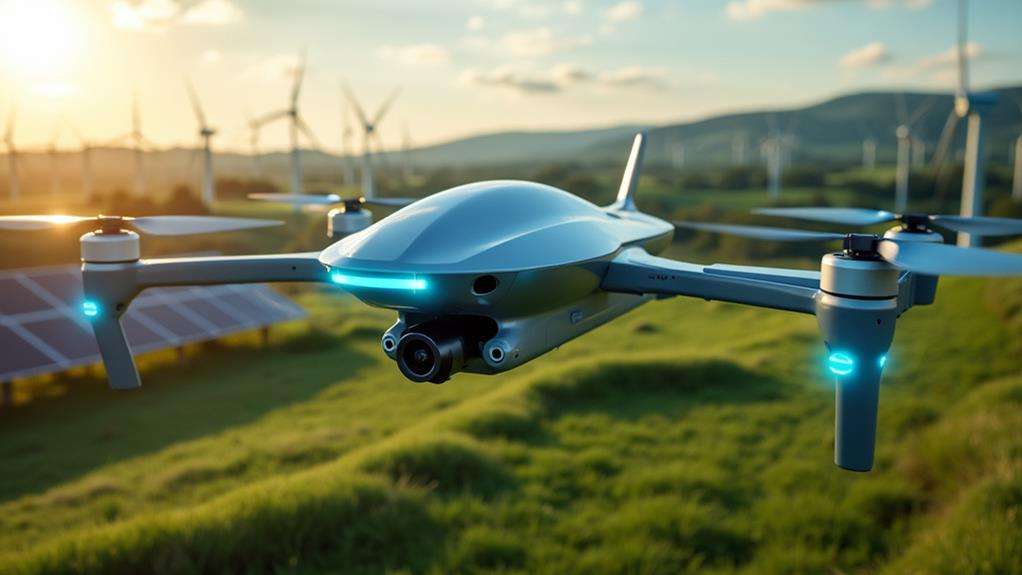
Embracing energy-efficient propulsion systems in UAVs represents a pivotal step toward reducing environmental impact and enhancing operational efficiency. By adopting electric and hybrid designs, Unmanned Aerial Vehicles (UAVs) can drastically lower emissions compared to traditional combustion engines. These advancements benefit not just the environment but also extend flight endurance, making UAVs ideal for long-duration missions such as environmental monitoring and search and rescue operations.
Energy-efficient propulsion systems enable UAVs to achieve longer flight times and carry heavier payloads, enhancing their operational capabilities and versatility. Improved energy efficiency is essential for sustainable UAV operations, allowing drones to minimize resource consumption while maximizing effectiveness.
The development of these propulsion systems is a key focus in the UAV industry, with continuous innovations improving both performance and environmental sustainability. As radio frequency technologies advance, we can anticipate even more efficient and adaptable UAVs. Embracing these advancements will make your UAV operations more capable and eco-friendly.
Advancements in Drone Technology
Drone technology is advancing rapidly, transforming various industries with groundbreaking capabilities. InDro Robotics exemplifies this progress, being the first in Canada to secure an air cargo license, thus setting the stage for significant developments in drone delivery.
Key innovations include:
- Night flight operations: Enabling extended operational hours.
- Urban flight capabilities: Allowing navigation through complex cityscapes.
- 5G integration: Facilitating enhanced real-time data transfer.
- Beyond Visual Line of Sight (BVLOS): Expanding the operational range.
- Increased payload capacity: Transporting up to 33 lbs, which is especially important for medical deliveries.
As these technologies evolve, drone safety standards are becoming increasingly crucial. Adherence to stringent guidelines minimizes risks and builds public trust. However, regulatory challenges remain, with authorities frequently updating policies to keep pace with rapid technological advancements. Companies must stay agile and compliant to navigate these evolving regulations effectively.
Optimizing payload strategies is another critical area of focus. Enhancements in flight times, payload capacities, and wind resistance are essential for drones to operate more efficiently and reliably. These improvements are particularly vital for industries that depend on fast, dependable deliveries, especially in remote or hard-to-reach locations.
The future of drone technology is promising, with continuous advancements pushing the boundaries of what is possible, ensuring that these innovations are trustworthy, interoperable, and relevant across various sectors.
Drones in Emergency Response
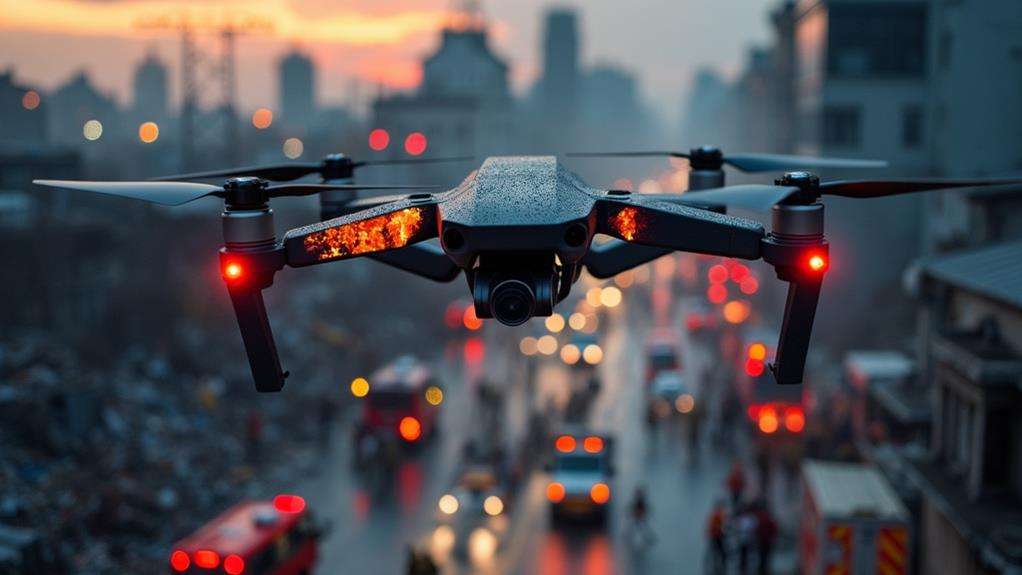
As drone technology continues to advance, its applications extend beyond commercial deliveries into life-saving missions. Picture a scenario where delivering medical supplies to remote locations typically takes 30-40 minutes. With drones, this delivery time can be reduced to mere minutes, significantly improving patient survival rates. Additionally, drones play a vital role in emergency communication by providing real-time data to first responders, thereby enabling more effective incident assessment and decision-making.
One of the primary advantages of drones in emergency response is their simplified operation. This allows emergency personnel to concentrate on critical tasks without being burdened by complex drone logistics. Moreover, drones can seamlessly switch between public and private networks, enhancing operational efficiency during crises.
| Feature | Benefit |
|---|---|
| Medical Supply Delivery | Rapid access to essential supplies |
| Real-time Data Sharing | Enhanced situational awareness |
| Seamless Network Switching | Increased operational efficiency |
| Simplified Operation | Focus on critical tasks |
| Revolutionized Aid Delivery | Significant impact in emergencies |
The deployment of drones in these scenarios has already transformed how aid is delivered, highlighting their immense potential for saving lives. By integrating drone logistics into emergency response protocols, faster, more efficient, and more effective operations can be ensured.
Future of AI in Drones
In the rapidly evolving landscape of drone technology, AI integration is transforming their capabilities. AI-driven drones now navigate complex environments independently, making real-time decisions without human intervention. This leap in autonomy allows drones to analyze data on the fly, adapt to dynamic conditions, and enhance operational efficiency.
Future advancements in AI aim to enable drones to learn and adapt independently, increasing their utility in high-risk industrial settings where human oversight is minimal. Potential applications include:
- Autonomous agricultural drones monitoring crop health and optimizing resource use.
- Surveillance drones providing real-time data in disaster zones to guide rescue efforts.
- Industrial drones inspecting hazardous sites, reducing the need for human exposure.
- Environmental drones mapping terrain and estimating slopes for better flight paths.
- Delivery drones navigating urban landscapes to ensure timely and accurate parcel distribution.
However, integrating AI in drones presents challenges. AI ethics are crucial to ensure that autonomous decision-making aligns with human values and safety standards. Regulatory challenges arise as authorities strive to update laws to keep pace with technological advancements. Additionally, user training is essential to equip operators with the skills needed to manage and troubleshoot these sophisticated systems. The future of AI in drones is promising, but it requires careful navigation through ethical, regulatory, and educational landscapes.

